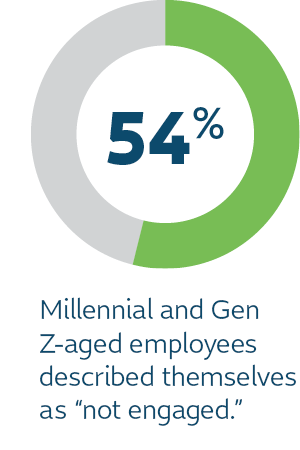Quiet Quitting is a Cry for Help; Here’s What You Can Do About It
How organizations can help their overworked and burned out employees.
“Nobody wants to work anymore.” How many times over the last two years have we heard that phrase? From Kim Kardashian to signs on businesses, we’re being told that people just don’t want to work hard anymore, if at all. But what if we told you this wasn’t true? People are working –a lot. According to the Bureau of Labor Statistics, full-time American employees work an average of 8.53 hours a day on weekdays and 5.89 hours on the weekend; that’s over 48 hours a week. And, they’re working in conditions that most people have never experienced all at once: a deadly pandemic, a bad-good-sorta bad economy, and social upheaval.
Out of the ashes of this has risen a new trend-of-the-day – quiet quitting. And, it’s having a moment. Gallup recently found that “quiet quitters” make up at least half of the U.S. workforce today, if not more. We’ve all seen the topic on LinkedIn and watched the videos on TikTok. Debates have been had and people have picked sides. Some praise it as a way for workers to take back their time and protect themselves from overwork. Others characterize it as passive aggressive and damaging, labeling quiet quitters as lazy employees who don’t really want to work.
Beneath the surface of the hashtags, social posts, and articles, though, quiet quitting isn’t new. It’s merely a symptom of the issues that have long been present in the workplace: ineffective manager-employee relationships; overwork and burnout; distrust; lack of equity and appreciation; disengagement; and toxic workplace cultures.

What is quiet quitting?
The pandemic has loudly shifted expectations from the workforce about their jobs and the ways they work, with more emphasis on working to live rather than living to work. Led by exhaustion, burnout, and stress, workers are actively attempting to rebalance their workloads by only working within defined work hours and refusing to take on additional work that they’re not compensated for — quiet quitting.
This may look like employees reigning in overtime or turning down a special assignment that stacks on top of an already heavy workload (e.g., leading an employee resource group). It can mean declining to take on additional tasks beyond their job description without having additional compensation or regular duties decreased or reassigned.
However it manifests, quiet quitting is a direct response to “hustle culture” and the always-on mentality that has dominated American worklife for decades. As one TikToker stated: it’s about not allowing yourself to be shredded with stress over work.

The risky business of quiet quitting
Quiet quitting is not without consequences. Choosing to quiet quit can lead to negative perceptions of slacking and laziness and is especially damaging to categories of workers who already struggle to gain employer attention, most notably people of color and women. Organizations also feel the repercussions with drops in productivity, strained team dynamics, the souring of manager-employee relationships, and high turnover.
But the debate around quiet quitting and whether it’s just laziness or another worker revolution is ignoring the most damaging aspect of it, which is right in front of our eyes and in the name itself — quiet. The quietness with which employees are attempting to rebalance is an indicator that they don’t feel like they can advocate for themselves in an open, honest, and transparent way. This lack of psychological safety speaks volumes about organizational cultures and the relationships (or lack thereof) between managers and their people.
Your organization’s efforts to engage employees flows through their relationships. Positive relationships encourage productivity, communication, and collaboration. If that’s lacking, quiet quitting becomes the silent underminer of your strategies and business objectives.
Employees who quiet quit aren’t saying, “I don’t want to work” but rather, “I don’t want to work like this.”
What are quiet quitters really trying to say?
At its core quiet quitting isn’t a “thing” or, at least, it shouldn’t be. Rather than being a cautionary tale on workplace laziness, it should be a wakeup call for organizations to focus on enhancing manager-employee relationships and creating new ways of working that don’t leave people stressed, exhausted, and looking at the clock. Employees who quiet quit aren’t saying, “I don’t want to work” but rather, “I don’t want to work like this.”

“You’re asking too much.”
Whether through cost cutting, layoffs, or employee turnover workloads have continued to rise and people are burned out. One of the greatest concerns regarding overworking and burnout is stress. Increased stress has been linked to a variety of health concerns, from depression and diabetes to high blood pressure and digestive issues.
As a manager, you have a huge responsibility to keep your team members focused, productive, healthy, and meeting deadlines. Schedule meetings with your teams to discuss workloads. Collaborate with them to plan their work, focusing on the hardest or big projects first. Before assigning special projects, ask what regular responsibilities may need to shift.
Check-in regularly with your team for progress updates but also be sure to ask them how you can help eliminate blockers. Create an atmosphere of teamwork and collaboration by sharing knowledge and information and encouraging others to do so as well. Ask your staff regularly to indicate whether they’re overworked, just right, or have spare capacity.

“My heart’s not in this.”
 A recent survey from Gallup found that employee engagement is declining, and it’s worse among younger workers. 54% of Millennial and Gen Z-aged employees described themselves as “not engaged.” There are any number of reasons employees may be disengaged: overwork, lack of recognition and career development, stress, role misalignment, murky goals, and distrust. Focus on what you can control and lean into your empathy to chart a new path.
A recent survey from Gallup found that employee engagement is declining, and it’s worse among younger workers. 54% of Millennial and Gen Z-aged employees described themselves as “not engaged.” There are any number of reasons employees may be disengaged: overwork, lack of recognition and career development, stress, role misalignment, murky goals, and distrust. Focus on what you can control and lean into your empathy to chart a new path.
Employees want to feel a sense of purpose so link personal drivers with team and organizational goals. Display and model your organization’s core values and talk about them in the context of your team’s work to clearly demonstrate the importance of what they do. Give people more autonomy over their work, and provide learning and career-development opportunities.
Publicly recognize good work and encourage your team to do the same. Create a two-way feedback loop, and share stories from customers or clients that show how your team is making a positive difference. This can be a powerful way to inspire your team members, and to keep them connected with the people that they’re helping.

“Work is not the most important thing in my life.”
Work can add fulfillment and satisfaction to our lives, but it’s still just one component of who we are. The pandemic made many of us re-evaluate what matters most. It brought into focus our own mortality and caused us to question the meaning of work while prioritizing other things – family, enjoyment, health, happiness. Although you alone can’t provide a 100% work-life integration for employees, you can help workers to find and maintain a balance that’s right for them.
Workers value employers who empower them to manage their own time and that means flexible scheduling and asynchronous work. Rather than count the hours employees work, try focusing on the completion of a particular task. Encourage your team to take their meal breaks, take a stroll, or even work in a different part of the office.
Lead by example by ensuring that you take the time you need to have healthy work-life integration. If your team sees you leaving the office on time, taking breaks, and not emailing out of office hours, they’ll do the same. Prioritize physical and mental health by reminding your people what benefits they have access to, encouraging them to take PTO, and openly discussing challenges.
Quitting quiet quitting – or preventing it from happening in the first place – means improving relationships and setting an example for your team.
Quit Quiet Quitting
Our work here at Blue Beyond has given us a unique appreciation for both organizational and employee challenges. If you suspect quiet quitting is becoming a thing in your organization, it’s vital to find out why. A cultural assessment can help uncover the reasons employees are taking a step back without vocalizing their frustrations. Doing an assessment will help you answer the big question: Does our culture nurture satisfied, engaged workers?
Quiet quitting behaviors are also a sign that manager-employee relationships have broken down. Rebuilding or strengthening them is a critical component in helping you connect more meaningfully with employees, to make sure they feel heard and understood. Our Beyond Skills workshops offer efficient training on topics that can be particularly helpful to mitigate quiet quitting, including emotional intelligence, delivering effective feedback, and keeping employees engaged even if your team is in multiple locations.
When employees can speak openly about the kinds of issues that lead to quiet quitting, you gain the opportunity to learn and make adjustments that help workers feel more appreciated, engaged, and balanced. Quitting quiet quitting – or preventing it from happening in the first place – means improving relationships and setting an example for your team.
